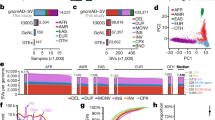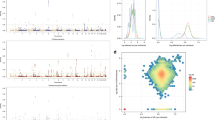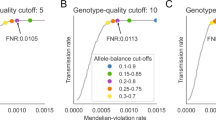Abstract
A major goal in human genetics is to understand the role of common genetic variants in susceptibility to common diseases. This will require characterizing the nature of gene variation in human populations, assembling an extensive catalogue of single-nucleotide polymorphisms (SNPs) in candidate genes and performing association studies for particular diseases. At present, our knowledge of human gene variation remains rudimentary. Here we describe a systematic survey of SNPs in the coding regions of human genes. We identified SNPs in 106 genes relevant to cardiovascular disease, endocrinology and neuropsychiatry by screening an average of 114 independent alleles using 2 independent screening methods. To ensure high accuracy, all reported SNPs were confirmed by DNA sequencing. We identified 560 SNPs, including 392 coding-region SNPs (cSNPs) divided roughly equally between those causing synonymous and non-synonymous changes. We observed different rates of polymorphism among classes of sites within genes (non-coding, degenerate and non-degenerate) as well as between genes. The cSNPs most likely to influence disease, those that alter the amino acid sequence of the encoded protein, are found at a lower rate and with lower allele frequencies than silent substitutions. This likely reflects selection acting against deleterious alleles during human evolution. The lower allele frequency of missense cSNPs has implications for the compilation of a comprehensive catalogue, as well as for the subsequent application to disease association.
This is a preview of subscription content, access via your institution
Access options
Subscribe to this journal
Receive 12 print issues and online access
$209.00 per year
only $17.42 per issue
Buy this article
- Purchase on Springer Link
- Instant access to full article PDF
Prices may be subject to local taxes which are calculated during checkout


Similar content being viewed by others
References
Ayala, F.J., Escalante, A., O'Huigin, C. & Klein, J. Molecular genetics of speciation and human origins. Proc. Natl Acad. Sci. USA 91, 6787–6794 (1994).
Risch, N. & Merikangas, K. The future of genetic studies of complex human diseases. Science 273, 1516–1517 (1996).
Collins, F.S., Guyer, M.S. & Chakravarti, A. Variations on a theme: cataloging human DNA sequence variation. Science 278, 1580– 1581 (1997).
Lander, E.S. The new genomics: global views of biology. Science 274, 536–539 (1996).
Saunders, A.M. et al. Association of apolipoprotein E allele ε 4 with late-onset familial and sporadic Alzheimer's disease. Neurology 43, 1467–1472 (1993).
Bertina, R.M. et al. Mutation in blood coagulation factor V associated with resistance to activated protein C. Nature 369, 64– 67 (1994).
Dean, M. et al. Genetic restriction of HIV-1 infection and progression to AIDS by a deletion allele of the CKR5 structural gene. Hemophilia Growth and Development Study, Multicenter AIDS Cohort Study, Multicenter Hemophilia Cohort Study, San Francisco City Cohort, ALIVE Study. Science 273 , 1856–1862 (1996).
Corder, E.H. et al. Protective effect of apolipoprotein E type 2 allele for late onset Alzheimer disease. Nature Genet. 7, 180–184 (1994).
Moriyama, E.N. & PowelI, J.R. Intraspecific nuclear DNA variation in Drosophila. Mol. Biol. Evol. 13, 261– 277 (1996).
Harris, H. The Principles of Biochemical Genetics (North-Holland/Elsevier, Amsterdam, 1975).
Harding, R.M. et al. Archaic African and Asian lineages in the genetic ancestry of modern humans. Am. J. Hum. Genet. 60, 772–789 (1997).
Nickerson, D.A. et al. DNA sequence diversity in a 9.7-kb region of the human lipoprotein lipase gene. Nature Genet. 19, 233– 240 (1998).
Li, W.-H. & Sadler, L.A. Low nucleotide diversity in man. Genetics 129, 513–523 (1991).
Chee, M. et al. Accessing genetic information with high-density DNA arrays. Science 274, 610–614 (1996).
Wang, D.G. et al. Large-scale identification, mapping, and genotyping of single-nucleotide polymorphisms in the human genome. Science 280, 1077–1082 (1998).
Underhill, P.A. et al. A pre-Columbian Y chromosome-specific transition and its implications for human evolutionary history. Proc. Natl Acad. Sci. USA 93, 196–200 (1996).
Li, W.-H. Molecular Evolution (Sinauer Associates, Canada, 1997 ).
Tajima, F. Statistical method for testing the neutral mutation hypothesis by DNA polymorphism. Genetics 123, 585–595 (1989).
Begun, D.J. & Aquadro, C.F. Levels of naturally occurring DNA polymorphism correlate with recombination rates in D. melanogaster . Nature 356, 519–520 (1993).
Nachman, M.W., Bauer, V.L. Crowell, S.L. & Aquadro, C.F. DNA variability and recombination rates at X-linked loci in humans. Genetics 150, 1133–1141 (1998).
Wayne, M.L. & Simonson, K.L. Statistical tests of neutrality in the age of weak selection. Trends Ecol. Evol. 13 , 236 (1998).
Lander, E.S. & Schork, N.J. Genetic dissection of complex traits. Science 265, 2037–2048 (1994).
Watterson, G.A. & Guess, H.A. Is the most frequent allele the oldest? Theor. Popul. Biol. 11, 141–160 (1977).
Zietkiewicz, E. et al. Nuclear DNA diversity in worldwide distributed human populations. Gene 205, 161–171 (1997).
Halushka, M.K. et al. Patterns of single-nucleotide polymorphisms in candidate genes regulating blood-pressure homeostasis. Nature Genet. 22, 239–247 (1999).
Eyre-Walker. A. & Keightley, P. High genomic deleterious mutations rates in hominids. Nature 397 , 344–347 (1999).
Weber, J.L. & Myers, E.W. Human whole-genome shotgun sequencing. Genome Res. 7, 401–409 (1997).
Venter, J.C. et al. Shotgun sequencing of the human genome. Science 280, 1540–1542 ( 1998).
Clark, A.G. et al. Haplotype structure and population genetic inferences from nucleotide-sequence variation in human lipoprotein lipase. Am. J. Hum. Genet. 63, 595–612 (1998).
Day, D.J., Speiser, P.W., White, P.C. & Barany, F. Detection of steroid-21 hydroxylase alleles using gene specific PCR and a multiplex ligation detection reaction. Genomics 29 152–162 (1995).
Nickerson D.A., Tobe, V.O. & Taylor, S.L. PolyPhred: automating the detection and genotyping of single nucleotide substitution using fluorescence-based resequencing. Nucleic Acids Res. 25, 2745–2751 (1997).
Henikoff, S. & Henikoff, J.G. Amino acid substitution matrices from protein blocks. Proc. Natl Acad. Sci. USA 89, 10915–10919 (1992).
Author information
Authors and Affiliations
Corresponding author
Rights and permissions
About this article
Cite this article
Cargill, M., Altshuler, D., Ireland, J. et al. Characterization of single-nucleotide polymorphisms in coding regions of human genes. Nat Genet 22, 231–238 (1999). https://doi.org/10.1038/10290
Received:
Accepted:
Issue Date:
DOI: https://doi.org/10.1038/10290
This article is cited by
-
The Emerging Role of Toll-Like Receptor-Mediated Neuroinflammatory Signals in Psychiatric Disorders and Acquired Epilepsy
Molecular Neurobiology (2024)
-
Soybean (Glycine max) isoflavone conjugate hydrolysing β-glucosidase (GmICHG): a promising candidate for soy isoflavone bioavailability enhancement
3 Biotech (2023)
-
PLEACH: a new heuristic algorithm for pure parsimony haplotyping problem
The Journal of Supercomputing (2023)
-
Detection of Transversions and Transitions in HBG2 Cis-Elements Associated with Sickle Cell Allele in Ghanaians
Biochemical Genetics (2023)
-
In-silico analysis unravels the structural and functional consequences of non-synonymous SNPs in the human IL-10 gene
Egyptian Journal of Medical Human Genetics (2022)



